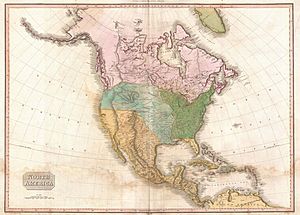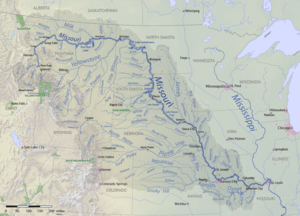Yellowstone expedition facts for kids

The Yellowstone Expedition was an important journey into the American frontier in 1819 and 1820. The United States Secretary of War, John C. Calhoun, approved this trip. Its main goal was to build a military fort or outpost where the Yellowstone River meets the Missouri River. This area is in what is now North Dakota.
People sometimes call it the Atkinson–Long Expedition. This is because its two main leaders were Colonel Henry Atkinson and Major Stephen Harriman Long. The expedition led to the creation of Fort Atkinson in Nebraska. This was the first United States Army base built west of the Missouri River. However, the expedition was very expensive and did not reach its main goal. It stopped near Council Bluffs, Iowa.
Contents
Why the Expedition Happened


Secretary Calhoun said the expedition was part of a plan. This plan aimed to help trade in the northwest. He also said it would "protect our northwestern frontier." This meant keeping the border safe. It would also help the fur trade grow.
The expedition started from St. Louis, Missouri. Its plan was to build several forts along the Missouri River. These forts would go all the way up to the Yellowstone River. The Yellowstone River is a major branch of the upper Missouri. It joins the Missouri in what is now western North Dakota. These forts were meant to increase America's presence in the fur trade. They also aimed to reduce British influence on the northern plains.
The first fort was planned for Council Bluff. This is not the same as Council Bluffs, Iowa. That city is 20 miles south. Council Bluff was where the Lewis and Clark Expedition met with the Oto and Missouria Native American tribes in 1804. William Clark had suggested this high bluff. He thought it was a good spot for a fort.
Getting Ready for the Journey
In 1818, Calhoun gave the contract for supplies and transport to James Johnson. James was the brother of Kentucky Congressman Richard Mentor Johnson. Richard had a lot of power over the expedition's money. This was because he led the House Committee on War Department spending.
People were very excited about the expedition. A newspaper in St. Louis said it was a great idea. But later, people were very disappointed. This was because the expedition did not meet its goals. There were also problems with the transport contract. It turned out that James Johnson was almost guaranteed not to lose money. So, he did not make sure his equipment was good enough.
Colonel Henry Atkinson led the Yellowstone Expedition. He commanded the 6th Infantry. In late 1818, he was told to move his troops. They were to meet the Rifle Regiment near St. Louis. The 6th Infantry quickly traveled 2,700 miles by land and water to get there.
The expedition also had a science and engineering part. Major Stephen Harriman Long, an Army engineer, was in charge of this. He chose a team of experts. These included people who studied animals, rocks, maps, and plants. There were also journalists and artists. This was the first time the U.S. government funded "Army Engineers" for such a trip. Their job was to map, study, and explore the huge unknown land. This land was between the Mississippi River and the Rocky Mountains.
The Steamboat Western Engineer
Major Long quickly planned to build a special steamboat. This boat would carry the scientists as far as possible. It was called the Western Engineer. It was designed to travel on the Missouri River. This river had narrow, shallow, and snag-filled parts. The boat had a very strong engine to fight fast currents.
Another new idea was a paddlewheel built at the back. This would protect it from damage from snags. The boat was built in Pittsburgh, Pennsylvania in 1818–19. It was probably the first stern-wheel paddle steamer ever made.
The boat was 75-by-13-foot (22.9 by 4.0 m). Its machinery was carefully placed. This helped it move easily in shallow water. To protect it from Native American attacks, Long added a bulletproof pilothouse. There was a cannon at the front. Howitzers were placed along the sides. The crew also had rifles and sabres.
People called it "Long's Dragon." This was because it was decorated like a snake. The idea was to scare away any hostile Native Americans. It was not like other steamboats of its time. Its bottom only needed 19 inches (48 cm) of water. Most steamboats needed 5 or 6 feet (1.5 or 1.8 m). Its basic design later became the model for other riverboats in the west.
A newspaper in May 1819 described the boat. It said the Western Engineer was well-armed. It carried a flag with a white man and a Native American shaking hands. The flag also showed a peace pipe and a sword. The boat was 75 feet long and 13 feet wide. It only needed 19 inches of water. The steam came out of the mouth of a large snake figurehead. This was the first steamboat to travel up the Missouri River into the Louisiana Purchase territory. It went all the way to Nebraska.
Starting the Journey
The 6th U.S. Infantry and 1st Rifle Regiments formed the military part of the expedition. They left St. Louis, Missouri in May 1819. Colonel Atkinson led 1,126 riflemen upriver. They were on three modern steamboats. Major Long followed in June with the scientists on the Western Engineer.
Important people on the expedition included Captain Stephen Watt Kearny. He later became a military governor of California. There was also painter Samuel Seymour, naturalist Titian Peale, and zoologist Thomas Say.
Atkinson's group had problems from the start. The steamboat captains were not good. Five steamboats were hired for Atkinson. But two never reached the Mississippi River. One of the others, the Thomas Jefferson, could not handle the snags and sandbars. It and its crew were left behind. The last two boats also got stuck. They stopped near the mouth of the Kansas River. They had to spend the winter there.
After many days and miles, Atkinson's troops had to change plans. They went back to using keelboats. These were like the ones used by Lewis and Clark years before. Men had to row, pole, or pull these boats upriver with ropes.
Autumn 1819 Activities
The expedition left the Kansas River on August 13, 1819. Two weeks later, they reached the Grand Nemaha River. On September 17, the steamboat Western Engineer arrived at Fort Lisa. This was a trading post owned by William Clark's Missouri Fur Company. It was on the west side of the river. This was about 20 miles north of today's Council Bluffs, Iowa.
"The Council Bluffs" was a general name for the land on both sides of the Missouri River. This was upstream from the Platte River. Fort Lisa was located a few miles below the original Council Bluff. This was where Lewis and Clark had met the Missouri and Otoe Native Americans in 1804. Today, this site is Fort Calhoun.
Atkinson's troops arrived on September 26. The groups then decided to build two winter camps. Atkinson's troops set up "Cantonment Missouri" near Council Bluff. Major Long's men set up "Engineer Cantonment" five miles downriver. This was near the western riverbank, half a mile upstream from Fort Lisa. Within a month, the camps were mostly finished. Major Long then went back east for new orders.
Winter 1819–20 Challenges
"Cantonment Missouri" was built along the river bottom. It did not last long. The winter of 1819–20 was very harsh. Also, the government contractors did not provide enough supplies. The soldiers suffered from widespread scurvy. This was due to poor food and lack of vitamin C. Over 200 of the 1,126 men died that first winter. It is thought that twice as many civilians might have died. No records were kept of their losses.
Finally, in the spring of 1820, the Missouri River flooded Cantonment Missouri. So, the soldiers built a permanent camp on top of Council Bluff. They renamed it Fort Atkinson. This fort was just east of present-day Fort Calhoun, Nebraska. It was abandoned in 1827.
Why the Expedition Failed
The expedition stopped at Fort Lisa. It was very expensive and did not achieve its main goals. Because of this, it was seen as a big failure. The government cut spending. It was also hard to supply forts so far away. These issues stopped the expedition from reaching the Yellowstone River.
In May 1820, Long returned to "Engineer Cantonment." He had new orders from the Secretary of War. He was told to stop work along the Missouri River. Instead, he was to explore the Platte River and where it started. The expedition left their winter camps on June 6, 1820. Colonel Atkinson led another expedition to reach the Yellowstone River in 1825.
Money Problems and Big Plans
Around the time the Yellowstone expedition left St. Louis, the country faced money problems. The costs of the expedition were much higher than expected. This was mostly due to problems with James Johnson's contract. His brother, Richard, also pushed for more money. However, James and Richard Johnson kept their good reputations. This was because they were popular in their home area.
In 1905, a writer named H.M. Chittendem wrote about the expedition. He said it was a "complete failure." He noted that troops could have marched much farther than the boats carried them. Yet, it was thought necessary to transport them in a grand way. As a result, it took a whole season to reach a point that could have been reached in two months.
He also wrote that the scientific part of the trip was too fancy. He believed if Major Long had used simpler equipment, his team could have explored for five years. They could have explored the whole area east of the mountains. This would have cost less than what they spent in 1819 alone. The small results from the first season and the contract problems made Congress unhappy. They refused to give any more money for the expedition.

